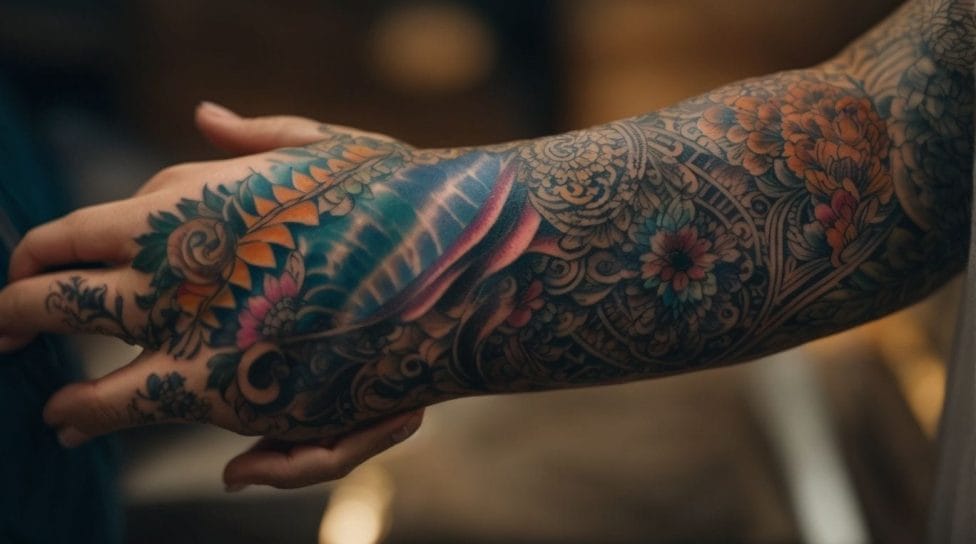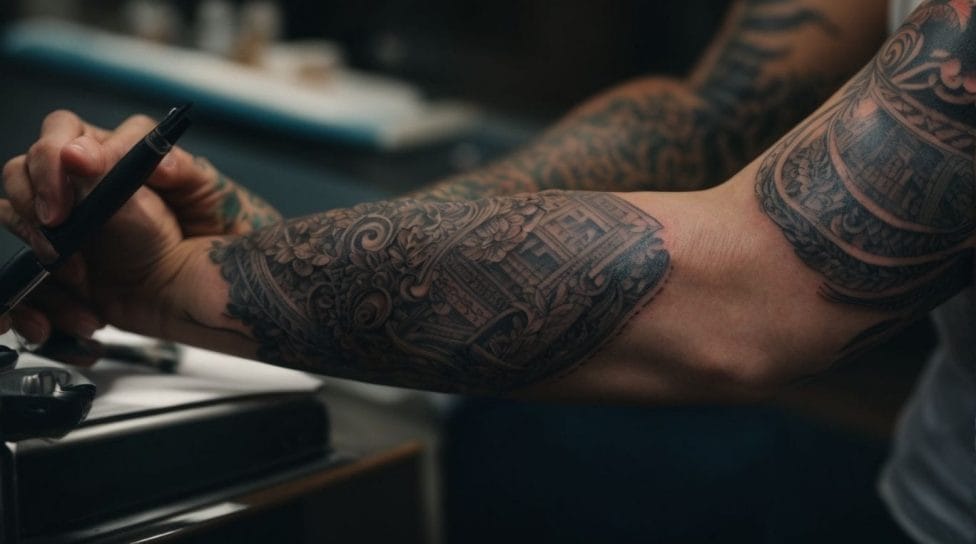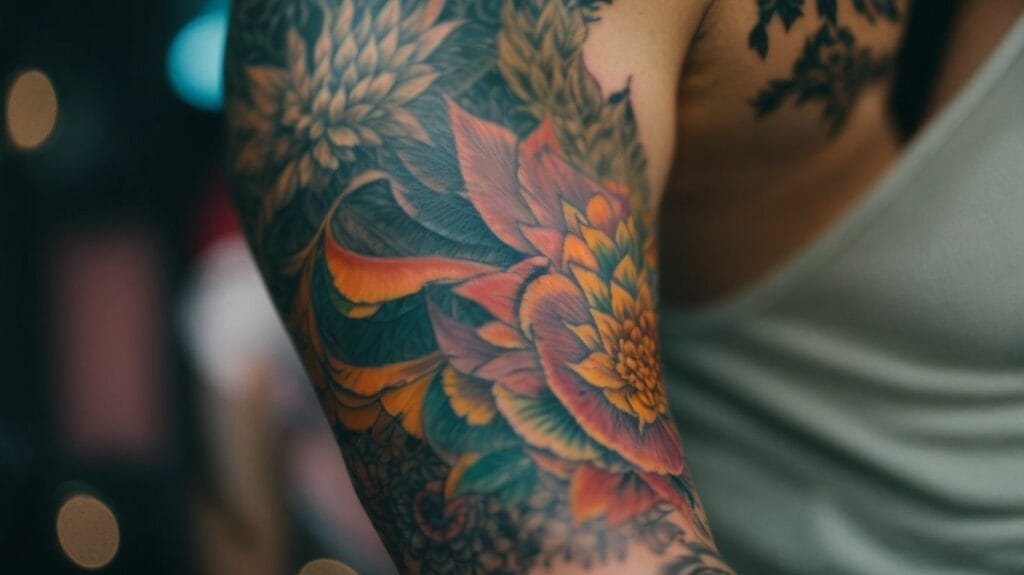Tattoos are a form of artistic expression and personal style, but one common question is whether arm tattoos hurt. The process of getting a tattoo involves the use of needles to inject ink into the skin, and it is natural to wonder about the level of discomfort involved. Let’s explore the factors influencing tattoo pain and understand the pain levels associated with arm tattoos.
Firstly, it is important to understand how tattooing works. The process of getting an arm tattoo typically involves the following steps, as per the guidance provided by experienced tattoo artists and online resources:
- The tattoo artist will clean and prepare the area of the arm where the tattoo will be placed.
- They will then create the tattoo design or transfer a stencil onto the skin.
- Using a tattoo machine, the artist will insert needles into the top layer of the skin, depositing ink pigments to create the desired design.
Several factors can influence the level of pain experienced during the tattooing process. These factors include the size and complexity of the tattoo, the placement of the tattoo on the arm, the individual’s pain tolerance, and the experience and skill of the tattoo artist.
While pain perception varies from person to person, it is generally accepted that getting an arm tattoo can involve some level of discomfort. However, the pain level can range from mild to moderate, and many individuals report that the experience is bearable.
Certain areas of the arm are more painful to tattoo than others. For example, the inner arm, near the armpit, and areas with thinner skin or more nerve endings may be more sensitive. On the other hand, areas with more muscle and fat, such as the outer arm, may be less painful.
Various strategies can help manage tattoo pain, such as using topical anesthetics, taking over-the-counter pain relievers, practicing deep breathing and relaxation techniques, and communicating openly with your tattoo artist.
Ultimately, everyone’s experience with getting an arm tattoo will vary, and it is crucial to consult with your tattoo artist and consider your pain tolerance before deciding to get inked.
Key takeaways:
- Getting an arm tattoo can be painful: The pain level of getting an arm tattoo can vary depending on several factors, such as the size, complexity, and placement of the tattoo, as well as individual pain tolerance.
- There are ways to manage tattoo pain: Some methods to manage tattoo pain include using topical anesthetics, taking over-the-counter pain relievers, practicing deep breathing and relaxation techniques, and communicating with your tattoo artist.
- Pain perception varies among individuals: Each person’s pain tolerance is different, so what might be painful for one person may not be as painful for another. It’s important to consider your personal pain threshold when deciding to get an arm tattoo.
How Does Tattooing Work?

Photo Credits: Tattooineplanet.Com by Kenneth White
How Does Tattooing Work?
Tattooing involves using a needle to inject ink into the dermis, the second layer of skin. The way tattooing works is that the tattoo artist first creates a design on the skin, then uses the needle to puncture the skin and deposit the ink. This process can cause mild to moderate pain, depending on the individual’s pain tolerance and the location of the tattoo. By creating tiny punctures in the skin, tattooing allows the ink to be absorbed and permanently stay in the dermis. To minimize discomfort, it’s important to choose a skilled tattoo artist, properly care for the tattoo afterward, and avoid areas of the body with thinner skin or more sensitive nerve endings.
What is the Process of Getting an Arm Tattoo?
The process of getting an arm tattoo involves several steps:
- What is the Process of Getting an Arm Tattoo? – Choose a design that suits your style and preferences.
- What is the Process of Getting an Arm Tattoo? – Meet with a tattoo artist to discuss your design and receive advice on size, placement, and customization.
- What is the Process of Getting an Arm Tattoo? – Prepare the skin by cleaning and shaving the area where the tattoo will be placed.
- What is the Process of Getting an Arm Tattoo? – The artist will create a stencil outline of the design on your arm.
- What is the Process of Getting an Arm Tattoo? – The artist will use a tattoo machine to apply the ink to your skin, following the stencil.
- What is the Process of Getting an Arm Tattoo? – Follow the artist’s instructions for proper aftercare to ensure healing and prevent infection.
Fun Fact: The process of getting an arm tattoo can take several hours, depending on the size and complexity of the design.
Factors That Can Influence Tattoo Pain

Photo Credits: Tattooineplanet.Com by Steven Martinez
Discover the elements that contribute to your tattoo experience in terms of pain. From the size and intricacy of the design to the precise location on your arm, each factor brings a unique level of sensation. Your personal pain tolerance and the expertise of your tattoo artist also play a significant role. Want to know some of the least painful areas on the arm for tattooing? Stay tuned as we uncover how these factors can influence the pain you may experience during your tattoo journey.
Tattoo Size and Complexity
- When considering the size and complexity of your arm tattoo, there are a few steps to keep in mind:
- Choose a design that fits the size of your arm and allows for intricate details if desired.
- Consider the time it will take to complete the tattoo based on its complexity.
- Discuss the size and complexity with your tattoo artist to ensure they have the skills and expertise to execute your vision.
- Remember that larger and more complex designs may require multiple sessions to complete.
- Remember that the size and complexity of your tattoo can impact the pain experienced during the tattooing process.
Fact: The size and complexity of a tattoo can also affect the healing process, with larger or more complex tattoos potentially requiring more time for proper healing.
Tattoo Placement on the Arm
When considering tattoo placement on the arm, there are several factors to remember.
- An inner bicep tattoo is highly visible and ideal for showcasing bold lines and intricate designs for tattoo placement on the arm.
- The rib cage, although a painful area for tattooing, may not be the best choice for those with a lower pain tolerance when deciding on tattoo placement on the arm.
- For tattoo placement on the arm, the upper/middle/lower back provides a less painful option, allowing for larger and more detailed designs.
- Another area to consider for tattoo placement on the arm is the outer arm/shoulder, which offers ample space for creative and eye-catching tattoos.
- It’s important to note that the elbow ditch/outer elbow tattoo can be quite painful for tattoo placement on the arm due to the thin skin and the presence of nerve endings.
Individual Pain Tolerance
Individual pain tolerance is a pivotal aspect when undergoing an arm tattoo. Everyone’s pain threshold varies, and what may be agonizing for one person may be bearable for another. Certain individuals possess a higher pain tolerance owing to factors such as prior tattoo experience, age, and mental readiness. It is vital to have open communication with your tattoo artist to ensure a mutual understanding of pain management techniques and expectations during the tattooing process. Having a clear comprehension and acceptance of your individual pain tolerance can enable you to make a well-informed decision and mentally prepare for the tattooing encounter.
The Experience and Skill of the Tattoo Artist
A skilled and experienced tattoo artist plays a crucial role in the tattooing process and can significantly impact the overall experience and outcome of getting an arm tattoo. The experience and skill of the tattoo artist are important factors to consider:
- Experience: Look for tattoo artists with a proven track record and years of experience in the tattoo industry. They have honed their skills and expertise, ensuring high-quality work.
- Portfolio: Review the tattoo artist’s portfolio to assess their style, technique, and attention to detail. This will help determine if their artistic vision aligns with your desired arm tattoo.
- Specialization: Some tattoo artists specialize in specific styles, such as realism, traditional, or geometric. Find an artist who excels in the style you want for your arm tattoo.
- Cleanliness and Safety: Ensure that the tattoo studio follows strict hygiene protocols, such as using sterilized equipment and disposable needles. A reputable tattoo artist values your safety and prioritizes cleanliness.
- Communication: A skilled tattoo artist will listen to your ideas, provide guidance, and ensure your vision is translated into a beautiful design. Clear communication is essential to achieve a tattoo that exceeds your expectations.
Least Painful Areas on the Arm for Tattooing
- The least painful areas on the arm for tattooing include:
- The upper arm: This area, with a significant amount of flesh and muscle, is considered one of the least painful areas for tattooing on the arm.
- The outer arm: With thicker skin and fewer nerve endings, this area results in less pain during the tattooing process.
- The front of the forearm: Due to less bone and muscle tissue, this area is relatively less painful for tattoos.
- The shoulder: With thicker skin and fewer nerve endings, getting a tattoo on the shoulder is considered less painful.
- The inner arm: While slightly more sensitive than the areas above, the inner arm is still considered one of the least painful areas for tattooing on the arm.
Consider these areas if you want a tattoo on your arm but have a lower tolerance for pain.
How Can I Manage Tattoo Pain?

Photo Credits: Tattooineplanet.Com by Dennis Young
Are we looking to manage tattoo pain? We’ve got you covered! In this section, we’ll explore various methods to help alleviate the discomfort of getting an arm tattoo. From using topical anesthetics to practicing deep breathing techniques, we’ll dive into different ways you can make the process a little less painful. Plus, we’ll discuss the importance of clear communication with your tattoo artist to ensure a smoother experience. No need to worry; we’ve got the tips and tricks to help you through!
Using Topical Anesthetics
Using topical anesthetics is one way to manage tattoo pain during the tattooing process. Here are some steps to follow when using topical anesthetics:
- Please consult with your tattoo artist: Discuss topical anesthetics with your tattoo artist beforehand to ensure it is safe and compatible with the tattooing process.
- Choose the right product: Select a topical anesthetic recommended by your tattoo artist or a dermatologist. Ensure it contains ingredients like lidocaine or benzocaine for numbing.
- Apply the topical anesthetic: Follow the instructions provided by the manufacturer to apply the topical anesthetic properly. Clean the skin before application and allow it to absorb for the recommended duration.
- Manage expectations: Remember that topical anesthetics can help reduce pain, but they may not eliminate it. Be prepared for some discomfort during the tattooing process.
- Communicate with your tattoo artist: Keep an open line of communication with your tattoo artist throughout the tattooing process. Let them know if you’re experiencing any discomfort or need a break.
- Follow aftercare instructions: After the tattoo is complete, follow your tattoo artist’s aftercare instructions to promote healing and minimize any potential pain or discomfort.
I used topical anesthetics during my arm tattoo session, and it helped make the experience more manageable. It numbed the area and significantly reduced the pain, allowing me to focus on the tattoo. I communicated closely with my tattoo artist, who ensured everything went smoothly. Following the aftercare instructions helped minimize any discomfort during the healing process. Using topical anesthetics can be a helpful tool for those looking to minimize tattoo pain.
Taking Over-the-Counter Pain Relievers
Taking over-the-counter pain relievers, such as acetaminophen or ibuprofen, can be utilized to manage tattoo pain during the tattooing process. These medications are known to reduce discomfort and inflammation effectively. However, it is crucial to follow the recommended dosage and consult with a healthcare professional before taking any medication. It is essential to note that while pain relievers can help alleviate the pain, they may not eliminate it as individual pain tolerance varies. Therefore, it is always advisable to discuss pain management options with your tattoo artist and adhere to their guidance. It is important to remember that pain is subjective, and what may work for one person may not work for another.
Throughout history, humans have always pursued ways to alleviate pain. Ancient civilizations like the Egyptians and the Greeks relied on natural remedies, including herbs and oils, to ease discomfort. In the 19th century, the development of over-the-counter pain relievers revolutionized the field of pain management. With continuous medical advancements, these medications have become increasingly accessible, relieving countless individuals worldwide. The ability to alleviate pain has significantly enhanced the quality of life for people, enabling them to tackle challenges with greater ease and comfort.
Practicing Deep Breathing and Relaxation Techniques
Practicing Deep Breathing and Relaxation Techniques can greatly help manage tattoo pain during the tattooing process. Here are steps to effectively incorporate these techniques:
- Focus on your breath: Take slow, deep breaths in and out to naturally and effortlessly calm your nervous system.
- Visualize: Immerse yourself in a peaceful and tranquil environment, allowing your mind to escape the pain.
- Muscle relaxation: Initiate the relaxation process from your toes, gradually ascending upwards and consciously releasing tension in each muscle group.
- Use distraction techniques: Engage in a lively conversation with your tattoo artist or bring a supportive friend to divert your focus.
- Listen to calming music: Curate a soothing playlist that redirects your attention from the potential discomfort.
- Express your needs: Maintain open communication with your tattoo artist so that you can request a brief respite or convey when the pain becomes overwhelming.
By incorporating and consistently practicing these deep breathing and relaxation techniques, you can significantly augment your pain management strategies and ensure a more pleasurable tattooing experience.
Communicating with Your Tattoo Artist
When it comes to getting an arm tattoo, it is crucial to engage in effective communication with your tattoo artist to achieve a successful outcome. Here are a few invaluable tips to help you effectively communicate with your tattoo artist:
1. It is of utmost importance to clearly articulate your design ideas and express your desired placement to your tattoo artist.
2. To better convey your vision, it is highly recommended to provide your tattoo artist with reference images or examples that align with your preferences.
3. Do not hesitate to ask pertinent questions about the tattooing process, such as pain levels and aftercare requirements.
4. Openly discuss any concerns or medical conditions that could potentially impact your tattooing experience with your artist.
5. Be receptive to suggestions and professional advice from your tattoo artist, as they possess extensive expertise within their field.
6. Throughout the tattooing process, maintain a continuous line of communication with your artist to allow for adjustments and provide feedback as necessary.
7. Should you experience discomfort during the tattooing session, do not hesitate to express it to your artist so that appropriate adjustments can be made.
By skillfully and effectively communicating with your tattoo artist, you will be able to ensure that your expectations are met and exceeded, resulting in a tattoo that you will adore.
Some Facts About Whether Arm Tattoos Hurt:
- ✅ Arm tattoos can cause varying degrees of pain. (Source: Our Team)
- ✅ The pain level experienced during an arm tattoo can be influenced by factors such as the location of the arm, individual pain tolerance, and the skill level of the artist. (Source: Our Team)
- ✅ The bony areas of the arm, such as the inner wrist and elbow, tend to be more painful for tattooing due to the proximity of bones and nerve endings. (Source: Our Team)
- ✅ Tattoo pain on the outer part of the upper arm tends to be less intense than in other areas. (Source: Our Team)
- ✅ The pain experienced during an arm tattoo can be managed through techniques such as deep breathing, numbing creams, or taking over-the-counter pain relievers. (Source: Our Team)


